About multi-band directional antenna is a dream of many hams. There are a number of technical solutions that enable you to create such a construction, but not all of them are easily reproducible in Amateur conditions. The author of this article offers readers an embodiment is a compact five-band directional antenna.
Directional rotating LW antenna 5 ranges (10 - 20 meters) and even 7 ranges (10-40m) - current Amateur radio design. Most leading world companies producing antennas for Amateur radio, have in the nomenclature of several five-band antennas that differ characteristics and price. Each company typically uses its used standard methods of implementation of multi-band. For example firm FORCE 12 applies the alternating arrangement of the different elements ranges (model XR5, 5VA), MOSLEY - a large number of resonance traps (PRO-67, PRO-96), HY-GAIN - automatic process active element in conjunction with "troponymy" Directors (TH-11), TITANEX variety of wire automatic process the antennas. The novelty of the proposed firm SteppIR elements of antenna change the dimensions of the Electromechanical actuator commands at the bottom microprocessor devices.
The article briefly describes the main advantages and disadvantages standard ways of creating MDA (Many-Band Antennas) and described their own option in dimensions three-element VK (Wave Channel) range 20 meters boom length less than 6 m to obtain a five-band (10, 12, 15, 17 and 20 meters) antenna. The total number of elements 16, and the mutual influence of elements minimized without the use of ladders. The performance of the antenna at each of ranges correspond almost three-element VK (!). The peculiarity of this options - part Director of range of 20 meters, the intercept with the help of two vacuum relays are used as the Directors of the ranges of 10 and 15 meters. In the antenna applied five-band active element with a simple scheme matching that allowed to feed her one cable without switching.
Characteristics of using MDA
For the analysis of MDA were used as given in the literature data, and calculations using a computer program antenna modeling MMANA[1].
Typically, in the design of such antennas tend to get on a separate the ranges of characteristics corresponding to a two - or three-element VK, so you should start with the identification of these characteristics. We will use the notation, taken in MMANA:
- Gh - amplification factor (gain) of the antenna in free space relative to half wave dipole, in decibels (dBd);
- Ga is the gain relative to isotropic radiator (dBi). Ga = + 2,15;
- Za = Ra + jXa - input impedance of the antenna;
- Front-to-Back or F/B - ratio of forward/backward. Numerically equal expressed in decibels the ratio of the magnitude of the anterior lobe of (NAM) to the value of the maximum posterior lobe of 180 ± 60 deg. To F/B reflect the actual ability of the antenna to weaken the steep rays (signals) from relatively close spaced stations adopted for calculations elevation (angle places) 50 deg, at ranges of 20 and 17 meters and 40 deg, on the other;
- SWR - standing wave ratio. In the future we will use the more familiar the CWS designation;
- BW1,5 and BW2 is the bandwidth of operating frequencies of the active element within the CWS more than 1.5 and VSWR less than 2. Since the program determines both the values it is convenient to introduce the index BW=BW1,5/BW2.
Calculate the characteristics of the three-element VK. This can be done for any frequency. Take f = 28,3 MHz (X = = 10.6 m), bandwidth of 600 kHz (28,0...of 28.6 MHz), the radius of the conductor r= 10 mm. When optimizing the antenna weight the coefficients for the parameters of the CWS, Gh and F/B taken respectively equal to 0.3; of 0.3 and 0.4.
The calculation will produce for three options:
Terms of calculating the antenna is in free space, F/B is defined for zero elevation. The calculated data are summarized in table. 1. Three numbers separated a slash correspond to the parameter values at the beginning (28 MHz), mid and the end of the working frequency band. When calculating BW assume that the input the aerial tuning unit SU, providing on average frequency SWR=1. The data shown in the fourth row of this table will be discussed next in "the Mutual influence of the passive elements of the VC on different bands".

When you change the calculated frequency in proportion to a change in the width of the working strip of frequencies. For example, when f = 14,15 MHz parameters G and F/B will be the same as in table. 1, but in the band 0.3 MHz. Also 2 times will be less than the value BW ( the condition that the radius of the elements will be increased proportionally, i.e. in 2 times).
Shortened elements
The most frequently shortening is achieved by including the inductors in each the shoulder element [2]. Of lesser number of characteristics of the elements in the first turn their broadband. A significant contribution to narrowing the operating band can to provide parasitic capacitance between the turns of the coil C0.
For example, the coil is L = 10 µh and C0 = 2 PF. At the frequency f = 28 MHz XL = coL = = j1760 Ω and XC = 1/ωС = -j2664 Ohms. The resistance of the parallel circuit of L and C0 would Xn = j[1760x(-2664)/(1760-2664)] = =j5187Ом. It turns out that taking into account the influence of C0 the actual value of the reactive resistance of the coil is increased in 5187/1760 = 2.95 times (respectively increased and the resistance losses), and the equivalent inductance of the circuit will be ХLэкв= 10x2,95 = 29,5 µh. The main the problem that arises due to the presence of C0, is that along with the growth the inductive resistance of the circuit increases and the rate of change in the transition from one operating frequency to another. So, in the case of the coil is zero when C0 changing the operating frequency to, say, one percent of the resistance of the coil XL will also change by one percent, and for our circuit, the change will be already much more - about 5 %.
The obvious conclusion is the capacitance of C0 should be as small as possible. This is achieved a single winding of the wire (preferably with a small step on the small frame the diameter. Here the experimental data. A coil of wire MGTF with diameter isolation of 1.55 mm, the diameter of the frame 23 mm, number of turns n = 41 (winding a coil to round) had measured the inductance L = 13 mH and Q = 260. With using GAD was determined resonant frequency of the circuit LCD (she was equal to fn = 42 MHz) and by calculation (MMANA) obtained a value of C0 =1,1 PF.
From the same wire run another coil on the frame with Its diameter of 50 mm. data - n = 20, L = 19 mH, Q = 340, f0 = 25MHz and C0 = 2,13 pF.
Dipole with traps
Consider a dipole designed for ranges 10 and 15 meters, dougdipnet which is achieved by using a resonant LC-traps, configured on the upper frequency f1= 28,5 MHz. At frequencies of 15-meter band the resistance ladder HT is inductive in nature and its value is determined values Kestucio and PT (PT comes in and C0). Obviously, the presence of the capacitor CT will affect the broadband dipole BWтаким same way as magwit-plated the capacitance C0.
Calculate bandwidth BW1,5 first single full-sized dipoles with the resonant frequencies f1 = 28,5 (dipole 1) and f2 = 21,2 MHz (dipole 2), and then crepaway dual band antennas. The calculations will produce three options for traps (ramp 1, ramp 2 and ramp 3) with the values of capacitance tra-povich capacitors - 15, 25 and 35 pF (inductance t respectively 2,08, and 0.89 to 1.25 μh) at the quality factor of the coils Q = 150 and the radius of the conductor g = 15 mm. calculation Results given in table. 2. The numbers in brackets show what proportion strip full-size dipoles has Trebova antenna at the appropriate range.

Calculation shows that this antenna significantly, 1.5...3 times, inferior full-size on the high bandwidth. Since this is due, primarily, more rapid growth of the input (own) reactivity, tripovich elements as passive considerably faster within the range and will change the indicator F/B.
From the calculated data it follows that the dependence of the bandwidth antenna crepaway on the top (10 meters) and lower (15 meters) ranges of the value of PT is opposite the character and setting of St - compromise task. On top the range more than the value of LT (less PT), the higher the resonant resistance loop-ramp and less than its impact on broadband antennas on this range. But on the bottom with increasing Kestucio decreases the total length of the antenna and accordingly its output.
Note an interesting feature is the short passive elements allow to get the best rate F/B than a full-sized, but in a narrow band of frequencies.
As for the losses in crepaway the antenna, the calculation gives the following values: tri-band single dipole length 7.4 m with two pairs of stairs when the quality factor of the coils Q = 150 loss in the range of 10 meters to 0.14 dB, 15 meters 0,78 dB and 20 meters and 0.59 dB. In the VC with troponymy elements total losses can to exceed 1 dB.
The mutual influence of passive elements VK different ranges
It is known that the placement of antennas of different ranges on the same boom elements lower frequency antennas can greatly affect the parameters of the antenna top ranges [3]. To assess this influence the calculation of parameters three VC-10 in the range 10 meters (f o = 28,5 MHz, see table. 1, line 1), located in the "environment" longer passive elements. For certainty, we believe that it is the Directors and reflectors VK bands 15 and 20 meters. The length of the elements D15, P15 and D20, P20, as well as their radii and the distance from center set on the basis of similar sizes and P10 D10 based of similarity coefficients (frequency ratio) K15 - 28,3/21,2 = 1,33 and K20 = 28,3/ /14,15 = 2 (Fig. 1). The calculation is carried out in stages. Calculation of VSWR and bandwidth BW produced by using an external matching device. At each stage used the mechanism of optimization of parameters of the VC-10. The results of the calculation are summarized in table. 3.
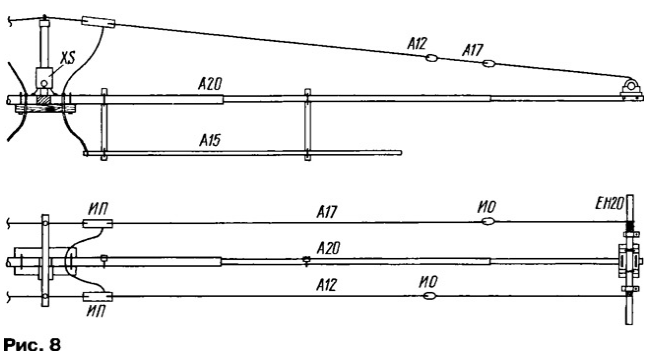
Calculated (lines 1 and 2) shows that it is located behind the reflector P10 conductors practically do not affect the settings of the VC-10. This is because, what field outside the reflector is very weak and in the rear of the conductors cannot to experience a noticeable current. The location of the reflectors, as in Fig. 1, widely used in multi-band antennas, especially in the case of multi-band active element, for example, with stairs or LOM coils [4].
In the case of the arrangement of longer elements "ahead" of the VC-10 (zone strong field) currents in these cells reach a considerable value. Their influence dramatically degrades the quality indicators of the VC-10 (lines 3, 4, 5), so these options should be avoided. Exceptionally possible that "long" the conductor is in the near zone of the active element (at a distance of 0.05 L, line 6) [3].
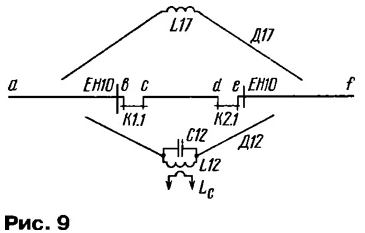
Actually, the question of application (location) Yagi elements is one of the major when developing multi-band antenna.
As an example, consider the case of a combined antenna consisting of a three-VK-20 with optimal inter-element distances and up to VC-10 (Fig. 2). The calculation of the VC-20 shows that his results practically coincide with the data table. 1 (line 1). Then the calculation (optimization) variables VC-10. For ease of comparison with indicators nesovmestnoi three-element antenna design data given in table. 1, line 4. It is seen that the addition of a second Director D10 had substantially to overcome the negative impact D20 and up to the VC-10 G and indicators F/B is very close to a three-piece (!), but the high bandwidth significantly inferior.
Another example is a combined 14-element antenna for tri-band C-31XR (FORCE-12) with a boom length of 9.3 m. the range of 10 meters antenna provides the gain of 7.3 dBd using the seven elements of this range [5]. Calculation shows that this increase can be achieved only four elements, therefore, the other three are aimed to compensate negative the influence of Directors of the lower ranges.
When building a five-band (10 - 20 meters) antenna use the compensation principle is not likely due to excessive complexity.
Multi-band active elements
In addition to the long-used tropologia and logoperiodicheskoi emitters are used and other relatively new species.
One of the most popular designs in three bands shown in figure 3.
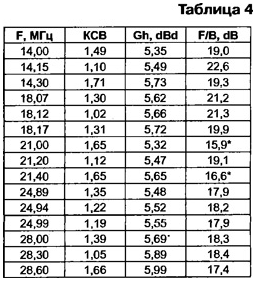
It consists of slotted dipole in the range of 20 meters and is located on a distance of 0,1 ...0,5 m two conductors with lengths close to 0.5 λ ranges on 15 and 10 meters. Due to the strong electromagnetic coupling between the system has three resonant frequencies. The selection of the length of the conductors and the distance to the dipole you can get the right value of the input resistance ranges 10 and 15 meters both in simple and in multi-element antennas. This design got the name of the open sleeve or C-R (coupled resonator) [6]. The lack option - relative escapologist. In particular, in order to cover the entire a range of 10 meters, it is necessary to use two conductor resonator lengths. One of them provides the lower section 28,0...29,0 MHz, and the second 29,0...29,7 MHz.
Good results can be obtained with a parallel connection of several close located dipoles with different resonant frequencies. When the distances between individual dipoles 0,3...0,5 m such active element can provide normal values in the range of 12, 15, 17 and 20 meters, and in combination with other methods and ranges 10, 30 and 40 meters [4].
Different types of five-band antennas (specific examples)
Logopaedica. The sample is very high for this class of antennas the data are given in [7]. The range is from 14 to 30 MHz, the number of elements - 13, the length of the boom - representation stands at 10.97 m, the gain in range 4, 85 5,65 dBd, F/B - 20...26 dB. Other design described in THE ARRL ANTENNA HANDBOOK and has more modest options - length boom 7.8 m, 12 elements, the gain of 4.4 .4.., 6 dBd and F/B - 14...21 dB. In both designs the elements were made of tubes of diameter about 25 mm. it Must be borne in mind that the antenna gain is reduced when the reduction of the diameter of the elements, so the wire in the performance of required more items than in the tubular antenna with the same gain. The presence of collective line and the need to isolate the elements from the boom substantially complicates and aggravates the design. Definite "plus" LP - only one feeder line.
In logopaedica with a large number of elements within each of the relatively narrow Amateur radio bands are active, as a rule, only three element. Because of the nature of the LSA, these elements are used less efficiently than in the "narrowband" EK. Therefore, if on a long boom positioning sequentially, one after another, five three-VC for ranges 10, 12,15, 17 and 20 meters, you can get more gain than logopaedica with the same the number of elements. Obvious structural defects such build - large the number of feeder lines (five) and a very large length of the boom. One of the ways solving the problem can be seen in Fig. 4.
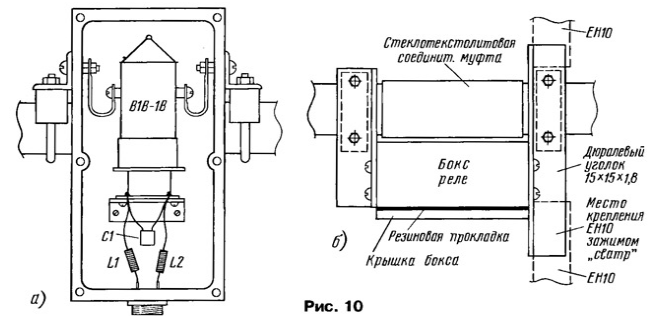
This model 5VA firm FORCE 12. Claimed performance of this antenna: gain within 5,4 5,9... dBd, F/B - 14...23 dB, the length of the boom - 9.9 m, 15 elements, 3 feeder line. The price of the antenna is about 1300 USD.
Antenna VMA 5
Five-band directional antenna VMA-5 developed by the author of this article. Here her data:
- operating ranges 10, 12, 15, 17, 20 meters;
- on each band uses a three-element VK, as having optimal the ratio performance/cost (efficiency is determined by the parameters G, F/B and BW);
- there is no negative impact on each other separate VC, the settings are stored single band antennas;
- the longitudinal size (length of boom) - not more than 6 m, i.e. the minimum at which it is still possible to get a "decent" indicators Gh > of 5.5 dBd and F/B > 20 dB at the range of 20 meters;
- used wire elements to "narrow-band" bands 12 and 15 meters to reduce sail area and weight of the antenna, and consumption of scarce aluminum tubes;
- applied one mains cable without switching (active sidepony "element").
All the resulting data calculation diagram of the antenna, the shape and the geometrical dimensions of the conductors elements, reactive load, and electrical performance ranges are in the file VMA-5.
General view of the antenna shown in the photo (Fig. 5)
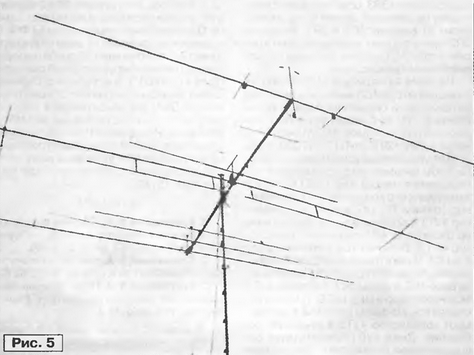
It consists of two assemblies - Yagi and active and a number of reflectors, located on the boom according to Fig. 6. The coordinates of the elements on the boom is defined by to the active element in the range of 20 meters (A20), the position of which taken as the zero point. Wire reflectors P12 and mounted R respectively over pipe P15 and P20 so that their middle is at the height of 0.5 m, and the edges on 0.15 m above the tubes.

The electrical circuit of the active part of the antenna shown in Fig. 7. It consists of four separate active elements A12, A15, A17, A20, connected in parallel among themselves and through the "shortening" of the capacitors C1 and C2 to the power cable, and a separate, linked through the field, dipole a10 system ("open sleeve"). Coordination on a range of 10 meters is achieved by selection of the length of the a10 and its distances from the main group. The length of the dipoles A12 - A20 selected more resonance so that the input resistance (active part) rose to Ra ≈ 50 Ω. The selection of the length of the dipoles and the capacitance compensating capacitors C1 and C2, and the provisions of passive elements on the boom and settings (length) managed to get to the center frequencies of all bands SWR of 1.05... 1,25.
The design of the active Assembly shown in Fig. 8 in two projections (build symmetric, only show one half). Insulators IP - plastic insulators type A ("Antinopolis", Zaporozhye), IO - insulators Marinova.

The base Assembly is that the element A20, made of duralumin pipe diameters (external/internal) 35/30 + 30/26 + 30/27 total length of 10 m At the ends A20 fortified small capacitive load IN. The use IS allowed:
- to reduce the length A20 from 11.4 to 10 m, which is especially important when you add in the antenna another range - 40-metre (see note at end of article);
- to unsubscribe from additional cross struts for attaching the ends of the braces wire A12 and A17.
As braces used double-folded polypropylene rope diameter about 3 mm. Pre-stretched with a force of 5 to 10 kg guy is screwed the tube IN (10...15 turns), then the end of the guy wire is fixed by a clamp (clamp).
Adopted by the curved shape of the A12 and A17 is possible to increase the distance between A20 and wire vibrators and thereby reduce the mutual influence. In addition, they successfully perform the role of stretch marks, preventing heavy A20 from severe depression, especially in the case of ice.
The A15 element is mounted below the A20 at a distance of 0.38 m using four dielectric spacers. When a selected distance of the broadband A15 decreases slightly by about 10 %. As the initial sites A15 used segments of a flexible cable RK75-4 (braid is soldered together and lived). Can use any copper stranded wire of diameter 5...8 mm weatherproof insulation, but it will be more expensive, and heavier.
The balancing is done using a protective inductor of 15 turns coaxial cable RG-58, wound on a ferrite magnetic core external with a diameter of 65 mm and a permeability of 300. When more power 200 watts should to use a more powerful cable. The inductor and capacitors C1, C2 type CU-2 200 pF placed in textolite box external dimensions 130x140x45 mm, bottom to a box attached angled coaxial connector type XS SR50-F. Box attached to the vertical bracket made, and as the upper horizontal the cross-beam, rolled steel thin-walled square shape dimensions 20x20 mm.
The mechanical connection of the halves A20 is produced by the coupling-insert, machined from solid glass fibre laminate core, the gap between the half - 50 mm A20 is attached to a glass fibre laminate plate dimensions h 100 x 19 mm by means of two U-shaped rods of stainless steel wire with a diameter of 6 mm. Active Assembly A12-A20 represents one easy-site. Item a10 is attached to boom separately by using U-shaped bracket and wing nuts.
The electrical circuit Yagi Assembly shown in Fig. 9. In its composition Yagi elements on all five bands. Structural basis for the Assembly serves as an intermediate element consisting of three isolated sections a-B, C-d, e-f, which can be connected via the contacts of relay K1.1 and K2.1.
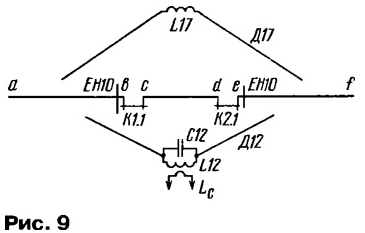
If both relays are turned on and the contacts are closed, the result element Yagi on a range of 20 meters (D20) with a length of about 9,65 m. When only one of relay, turns out element Yagi for 15 meters range (D15). It will be the element a-b-C-d or C-d-e-f depending on which relay is on, and what off. Because D15 is located asymmetrically with respect to the axis of the antenna (boom), and chart orientation (LTO) will also be somewhat unbalanced. The calculation shows that the front lobe deviates from the axis of the antenna slightly - by about 5 degrees, but it is not accompanied by a drop gain (deformation of the rear lobe will be shown below). When both relays off, end sections a-b and e-f operate as two Directors of the range 10 meters. The lengths of these sections is insufficient for normal operation, so the inner ends of sections (B and e) has two capacitive load IN. This dual Director affects the parameters of the antenna on this band almost also, as usual unary, located directly on the boom. It can be noted that in D15 and D20 (when the closed relay contacts) influence IN slightly.
With this method of "organization" of the Directors of the three main ranges fully eliminated their mutual negative influence, as well as their impact (if open the relay contacts K1, K2) and on the bands 12 and 17 meters. In addition, humanists the flow dural pipes approximately 11 m, windage and weight of the antenna.
Yagi, the Assembly is located at a distance of 2.85 m from the A20 motorway. This is a compromise value. At a greater distance will decrease rapidly indicator F/B on a range of 10 meters, and when it is smaller to deteriorate most of the indicators the range of 20 meters.
The Director of the applied high-frequency vacuum relays (switches) B1 b-1B with valid values 1=10 and U=3 kV. Calculation shows that such current and the voltage at the Director consistent with the input power of the antenna is not less than 5 kW. Temperature range relay - from -60° to +100°, the guaranteed number switching - 100000.
The measured value "pass" capacity open relay - about 0.9 pF, given the parasitic capacitance of the installation in the analysis model inherent value 1.5 pF (table loads, pulse w35c, w36c). The closed condition of the relay correspond to these same loads, but the magnitude of over 100,000 PF (equivalent to K. W., see "comment" to the file, VMA-5). The calculation shows that the permissible use relays with "pass" with a capacity up to 5 PF with the adjustment of the dimensions of the component parts of the D20 and IN. In particular, you can try common sealed relay REN-33 when parallel-consistent inclusion of all four contact groups.
The Directors of the ranges of 12 meters (d) and 17 m (D) is made of wire. For eliminate the negative impact of these elements on the higher frequency settings the ranges of the following measures.
1. The Directors of all five bands are located in the same vertical plane. Calculations show that with this arrangement, their mutual influence is reduced.
2. Possible strong influence d in the range of 10 meters (along its length d would be in the range of 10 meters full reflector) is eliminated by using parallel circuit-antitype L12C12 with the tuning frequency of 28.3 MHz, installed in the middle part d. Why anticrop? The purpose of the ladder is to allocate from the antenna element portion, the size of which is close to resonance. Appointment antitype opposite - cut element into segments whose sizes much less resonance. In order not to affect the broadband range 12 meters, taken unusually small reactivity - C12=150 pF and 1.12=0,21 µh, 8... 10 times smaller than standard ladder. Despite this, the resonant the resistance of the circuit is sufficient to perform its primary function. Provided communication revolution Lc, which together with the SWR meter bridge type you can determine the resonant frequency of the circuit.
3. In the middle part D included inductance L17=4 µh. This leads utter a word when working at frequencies of 21 MHz and higher induced in A current substantially reduced - L17 like dissecting D into two halves. Thanks the deterioration indicator F/B on the upper ranges under the influence D does not exceed 1 dB. To simplify the design L17 made of two identical close located coils (L17' and L17") with an inductance of 2 mH each. Introduction L17, of course, affects the output of the antenna parameters on the range of 17 meters, but significantly it is already apparent outside of the work area frequencies (see tab. 4).
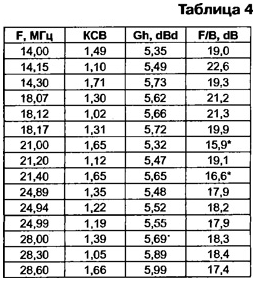
The design of the middle part of the directory of the Assembly shown in Fig, 10. Applied pipe - Central part diameter 30/26 mm, insulation inserts glass fibre laminate rods, end sections of pipe diameters 30/27 and 22/20 mm capacitive load - 16/13,8 mm.
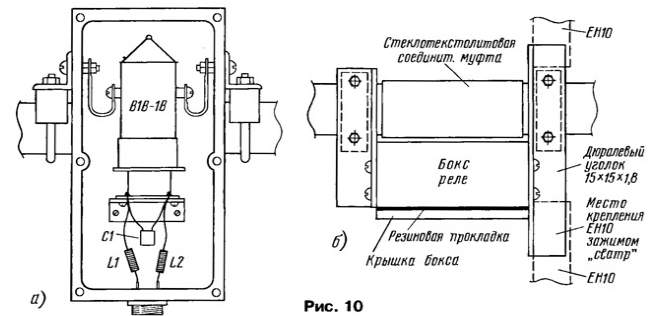
The middle part of the D20 is attached to the boom through the glass textolite plate (Fig. 10, (a) dimensions 270x95x12 mm. Each of the coils L17 wound on plastic the antenna insulator type A the same wire as in D (Fig. 10,6). In Fig. 11 shows box (box dimensions 70x120x35 mm, milled from the PCB) relay VW-1B and the method of its attachment to the D20 roll (the mount is easily removable). The power to the relay is supplied through connector RSV. Power wire relays are divided into sections of length about 2 m using a choke type PDM-1.2 for mg. In its middle part wire tied to the cross bracket. The capacitor C1 is C-11-3 capacity 2000 PF.

Effect asymmetric D15 on the boom can be induced currents that will lead to additional asymmetry days on the range of 15 meters. To avoid this trouble, the final part of the boom (by the Directors) of length 2 m separated from the rest of the boom textolite insert.
Testing of antennas and calculation of electrical parameters were made in relation its position in free space. At the height of the antenna above the ground more than 20 m will not change very much.
There are two options of payment: to achieve the best possible performance G and F/B in any part of its range and to achieve the greatest uniformity indicators within the entire range. In the second case, on average frequency the range of the gain will be less than 0,2...0,4 dB. Selected, wherein the parameters are optimized for the sites ranges 14,0...14,3 , 21.0 21.4% and... 28,0.-28,6 MHz. If optimization were covered and the upper, little used portions of the bands, this inevitably worsen the indicators "below", on Telegraph the plots. For bands 12 and 17 meters calculations based on the maximum F/B on medium frequencies. The results of the calculations are summarized in table. 4.
The point about marked with an asterisk * values of the parameter F/B at frequencies 21,0 21.4 MHz. In Fig. 12 and 13 show two days for the same frequency 21,0 MHz obtained depending on which of relay K1 or K2 is turned on. These days practically the only difference is the shape of the rear side (mirror symmetry). So as relay operatively controlled from the remote station, an interference with any direction in the rear half-plane, as can be seen from the drawings, can be suppressed to 21...24 dB. For comparison in Fig. 14 shows days on average frequency of 21.2 MHz.
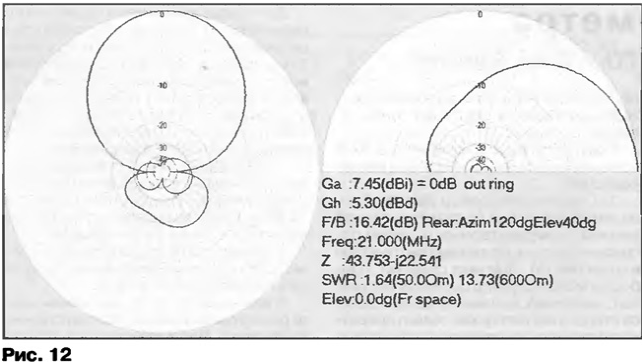
Mentioned in the first article of antenna 5VA (FORCE-12) and 13-item-tion at LCCC electrical parameters are close to the SCA-5. Above mentioned stated the parameters of 5VA: strengthening within 5,4 5,9...dBd, F/B - 14 to 23 dB, length boom - 9.9 m, 15 elements, 3 feeder line. The consumption of aluminium tubes is: VMA-5 - 63m (including boom and capacitive loads), 5VA - about 110 m, LCCC is about 100 m. it is also clear that the two antennas have the last much greater wind resistance and weight.
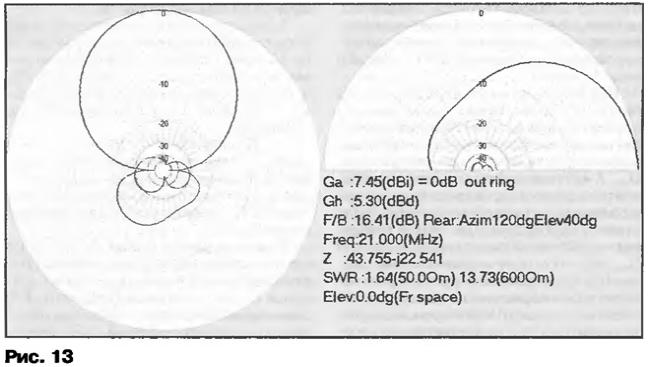
Design VMA-5 has an experimental character: all tube elements have adjustable end sections, the length of the wire is regulated in the end the insulators, and the elements can be moved around the boom. This gives you the opportunity to the experiment, if necessary, to clarify the accounting data.

In particular, the formula does not take into account the influence of the "earth" in the first place, because that QTH author in various directions from the antenna parameters of the earth differ dramatically. Made, it is estimated that the antenna was originally installed at a height of 1.8 m above the roof ridge slate roof and a small adjustment of the lengths of the active elements (lengths IN in A20) resonant frequencies were using an SWR of meteoustanovki on "place". Then followed climb to a working height of 6.5 m above the roof ridge of the four houses and 25 m above land and parameter validation. Basic check F/B at three frequencies each the range produced by the signals of local stations UT1MQ in receive mode. In the receiver was switched on manually adjust the gain level of the signal at the LF output were monitored with a voltmeter V7-37. The measured values of F/B was in the range of 18...30 dB. An interesting experiment was able to spend with Arthur (4X4DZ). For 20 min both sides "running off" each other with their antennae (Arthur - TH-11) all five bands, the result on both sides approximately equal to F/B the average level of 20 dB (W...Balla). The value of VSWR and bandwidth BW is close to settlement, serious measure the gain of the antenna has not yet been performed.
In the design of the SCA-5 there are some differences from calculation model:
- the wire elements are made of flexible stranded wires in isolation pvz 2.5 mm2. The version of the program MMANA used by the author, is "not able" to read the guides in isolation, so the calculation is made under the "bare" wire, and the actual length was taken considering the velocity factor Ku. The experiment showed, what Ku depends on insulation thickness and frequency and for THP-2.5 LW range is about to be 0.97 (preferably clarified);
- the initial sections A12 and A17 ( up to the top of the insulator) is made with a smooth curve, and the model had to show straight lines. The same applies to primary wire sections A15. The model is also difficult to show embed wire in the insulator. So I had to assume full equality settlement the length of the element and full length real wire (including DTS). It applies to the Directors d and D.
It should also be noted that the reactive load in the program are defined as point, and the real L and have their length, and this may affect the accuracy of calculation.
Based on the SCA-5 model developed semidiapazonny antenna comprising two object on the ranges of 30 and 40 meters. Perhaps, over time this model will be able to implement in hardware.
Part of this model is the active element in the range of 40 meters (A40) already applied (as a Supplement) to an existing antenna (see Fig. 5 photo). A40 made on the basis of A20 by adding to each of its ends, a coil with inductance 20 µh and end of the section length of 1.41 m (LOM) technology. The length of the capacitive loads had to increase.
In conclusion it can be noted that the electromagnetic relay begin to appear in brand antennas (MAGNUM FORCE 280-12, TITAN EX, etc.) and the Amateur developments [8].
The author is grateful to Boris Kataeva (UR1MQ) for the great help in the process of installation VMA-5 and Alexander blow your horn (UT1MQ) for participating in the measurements.
Literature
Author: Ernest Gutkin (UT1MA), Lugansk, Ukraine






